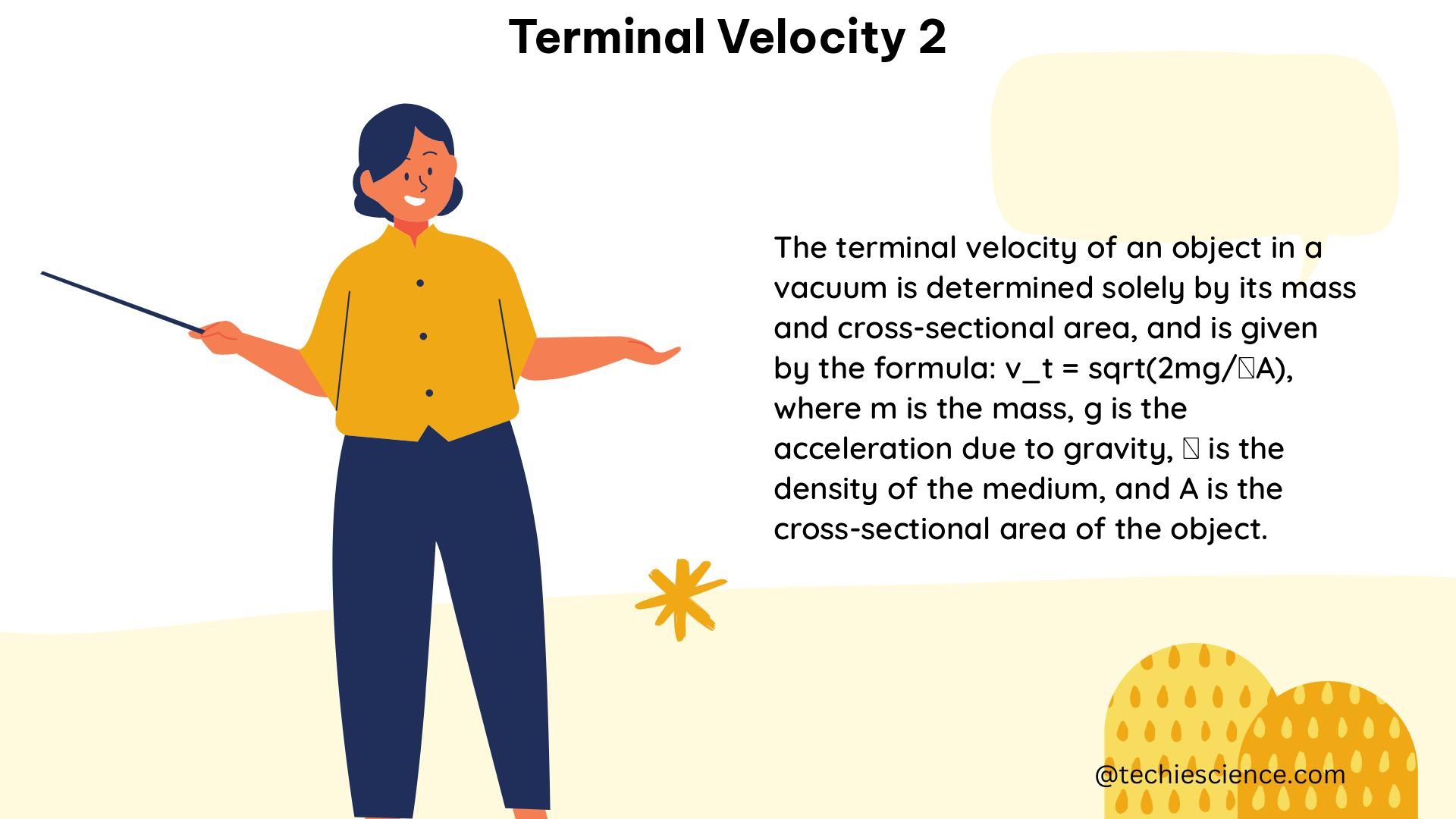Terminal velocity is a fundamental concept in physics, describing the maximum speed an object can reach as it falls through a fluid, such as air or water. This phenomenon occurs when the force of gravity acting on the object is balanced by the force of drag. Understanding terminal velocity is crucial for various applications, from skydiving to the design of parachutes and other aerodynamic systems.
The Terminal Velocity Formula
The terminal velocity of an object can be calculated using the following formula:
[V_t = \sqrt{\frac{2mg}{\rho A C_d}}]
Where:
– $V_t$ is the terminal velocity (m/s)
– $m$ is the mass of the object (kg)
– $g$ is the acceleration due to gravity (m/s²)
– $\rho$ is the density of the fluid (kg/m³)
– $A$ is the cross-sectional area of the object (m²)
– $C_d$ is the drag coefficient (dimensionless)
This formula allows us to determine the terminal velocity of an object based on its physical properties and the characteristics of the surrounding fluid.
Example Calculations

Let’s explore some examples to better understand the application of the terminal velocity formula.
Flat Piece of Paper
- Mass: $m = 0.0045$ kg
- Area: $A = 0.06$ m²
- Drag Coefficient: $C_d = 1.17$
- Density of Air: $\rho = 1.2$ kg/m³
- Terminal Velocity: $V_t = \sqrt{\frac{2 \times 0.0045 \times 9.8}{1.2 \times 0.06 \times 1.17}} = 1.02$ m/s
Crumpled Piece of Paper
- Mass: $m = 0.0045$ kg
- Area: $A = 0.0075$ m²
- Drag Coefficient: $C_d = 0.5$
- Density of Air: $\rho = 1.2$ kg/m³
- Terminal Velocity: $V_t = \sqrt{\frac{2 \times 0.0045 \times 9.8}{1.2 \times 0.0075 \times 0.5}} = 4.4$ m/s
These examples demonstrate how the terminal velocity of an object can vary significantly based on its physical characteristics, such as mass, cross-sectional area, and drag coefficient.
Experimental Methods
To determine the terminal velocity of an object, you can use various experimental methods:
Video Tracking
- Record the motion of the object using video tracking software.
- Analyze the data to determine the terminal velocity.
Distance and Time Measurements
- Measure the distance from which terminal velocity starts to when the object hits the floor.
- Measure the time spent in terminal velocity.
By using these experimental methods, you can gather empirical data to validate the theoretical calculations and gain a deeper understanding of the terminal velocity phenomenon.
Data Analysis
To further analyze the terminal velocity data, you can employ the following techniques:
Graphical Representation
- Plot the terminal velocity against the mass of the object.
- Use a power fit to determine the relationship between terminal velocity and mass.
R-Squared Value
- Calculate the R-squared value to determine how well the equation fits the data.
- A higher R-squared value indicates a better fit, suggesting the terminal velocity formula accurately represents the observed data.
These data analysis techniques can help you validate the theoretical models, identify any discrepancies, and gain insights into the underlying physics governing terminal velocity.
Advanced Considerations
To further explore the concept of terminal velocity, you can consider the following advanced topics:
Fluid Dynamics
Investigate the role of fluid dynamics, such as viscosity, turbulence, and boundary layer effects, in determining the terminal velocity of an object.
Drag Coefficient Variations
Explore how the drag coefficient can change based on the object’s orientation, surface roughness, and other factors, and how these changes affect the terminal velocity.
Buoyancy Effects
Incorporate the effects of buoyancy, especially in the case of objects falling through liquids, and how it influences the terminal velocity.
Atmospheric Conditions
Analyze the impact of atmospheric conditions, such as temperature, pressure, and humidity, on the terminal velocity of objects falling through the air.
By delving into these advanced topics, you can gain a more comprehensive understanding of the complex factors that influence terminal velocity and develop more accurate models for various applications.
Conclusion
Terminal velocity is a crucial concept in physics, with numerous practical applications. By understanding the terminal velocity formula, conducting experimental investigations, and employing data analysis techniques, you can deepen your knowledge of this fundamental phenomenon. This guide has provided you with the necessary tools and insights to explore terminal velocity 2 in a comprehensive and hands-on manner. Remember to continue exploring the advanced topics and pushing the boundaries of your understanding to become a true expert in this field.
References
- Libretexts. (2024). Unit 8 Lab Extension- Modeling Terminal Velocity and Extracting Drag Coefficient. Retrieved from https://phys.libretexts.org/Bookshelves/Conceptual_Physics/Body_Physics_-_Motion_to_Metabolism_%28Davis%29/14:_Lab_Extension_Activities/14.06:_Unit_8_Lab_Extension-_Modeling_Terminal_Velocity_and_Extracting_Drag_Coefficient
- Open Oregon. (n.d.). Unit 2/3 Lab: Testing a Terminal Speed Hypothesis – Body Physics. Retrieved from https://openoregon.pressbooks.pub/bodyphysics/chapter/unit-2-lab-distance-learning-compatible/
- Physics Forums. (2015). An experiment from which you can calculate terminal velocity. Retrieved from https://www.physicsforums.com/threads/an-experiment-from-which-you-can-calculate-terminal-velocity.844565/
- Study.com. (n.d.). Terminal Velocity Definition, Formula & Examples – Lesson. Retrieved from https://study.com/learn/lesson/terminal-velocity-formula-examples.html
- msuperl.org. (2019). free_fall [Data Lab]. Retrieved from https://www.msuperl.org/wikis/datalab/doku.php?id=free_fall

The lambdageeks.com Core SME Team is a group of experienced subject matter experts from diverse scientific and technical fields including Physics, Chemistry, Technology,Electronics & Electrical Engineering, Automotive, Mechanical Engineering. Our team collaborates to create high-quality, well-researched articles on a wide range of science and technology topics for the lambdageeks.com website.
All Our Senior SME are having more than 7 Years of experience in the respective fields . They are either Working Industry Professionals or assocaited With different Universities. Refer Our Authors Page to get to know About our Core SMEs.